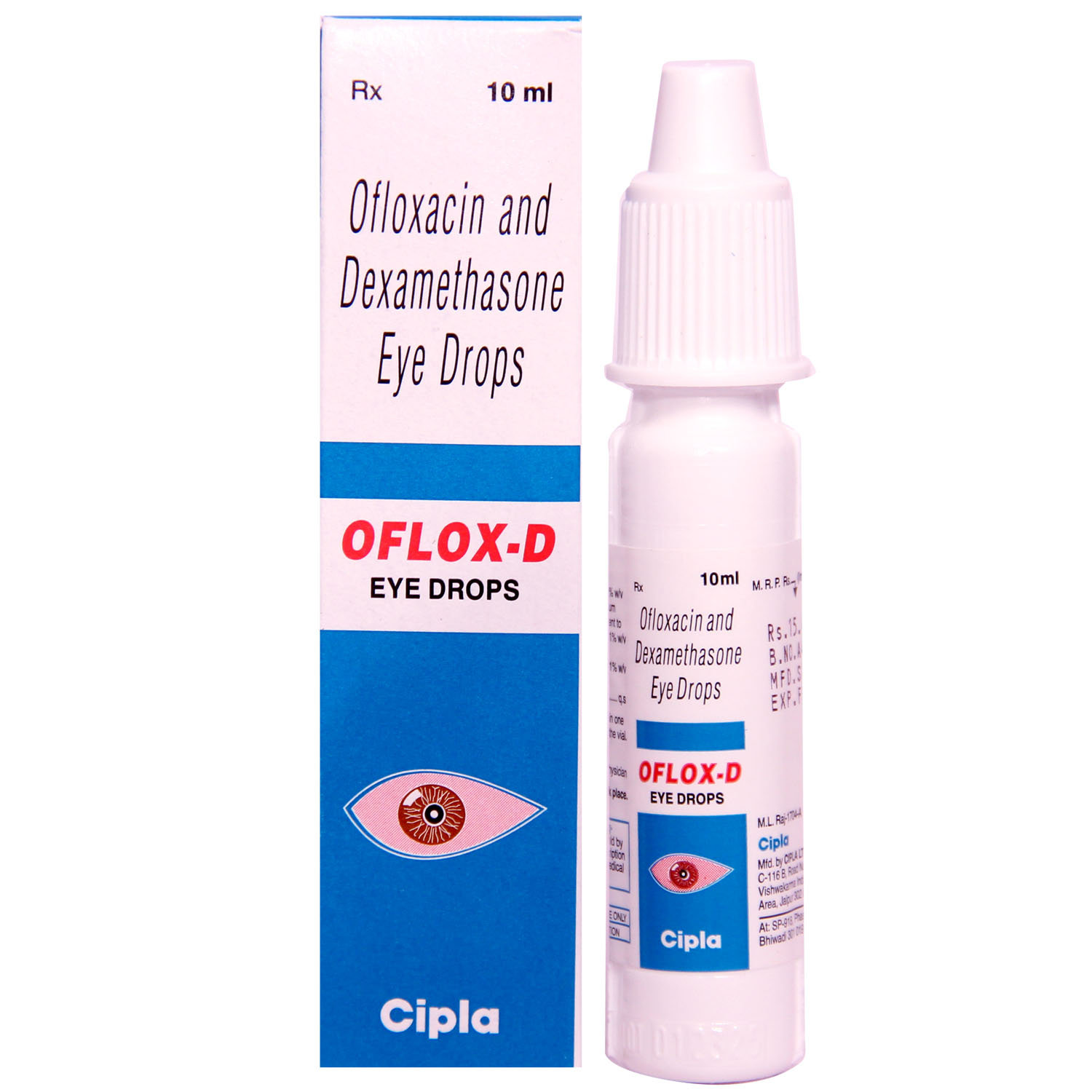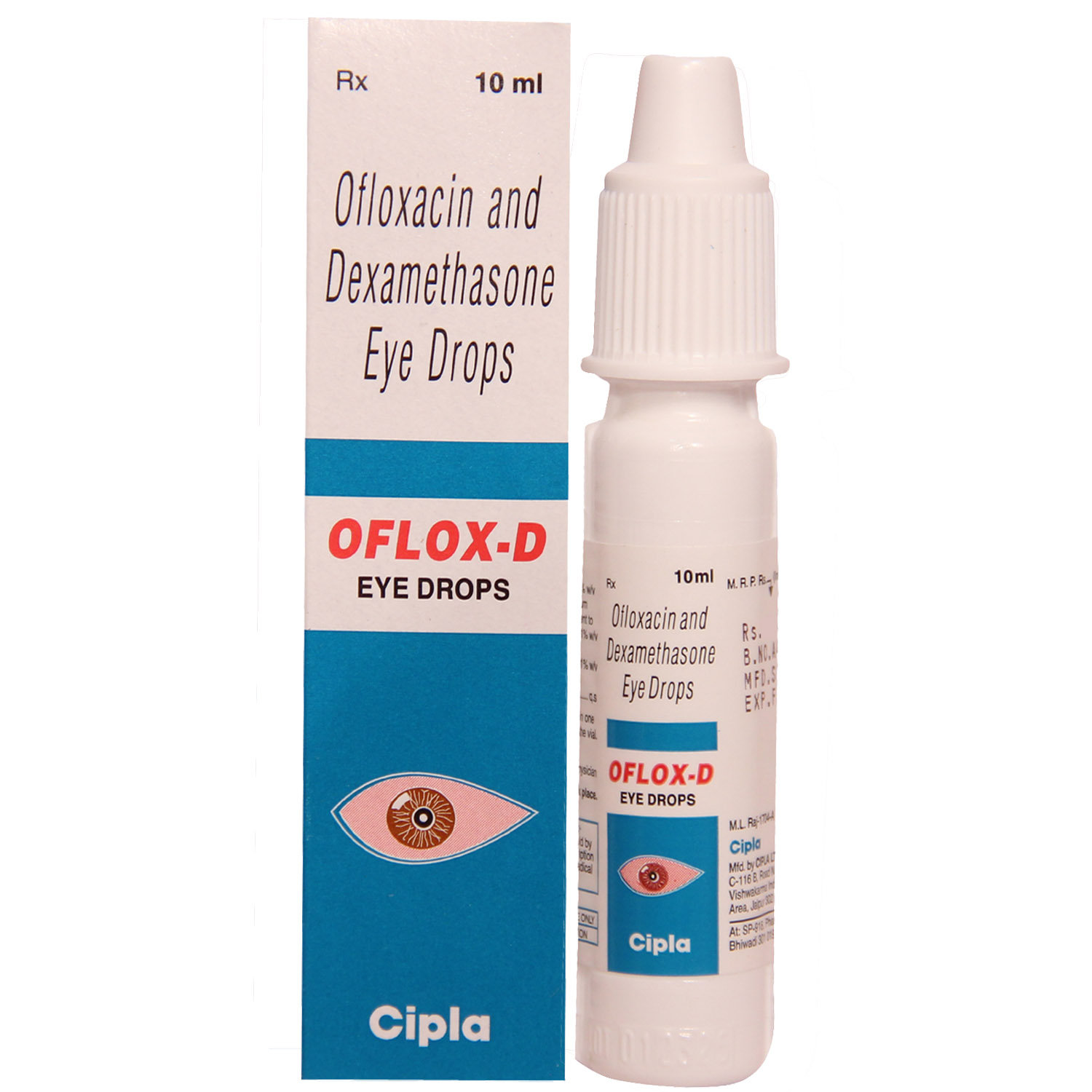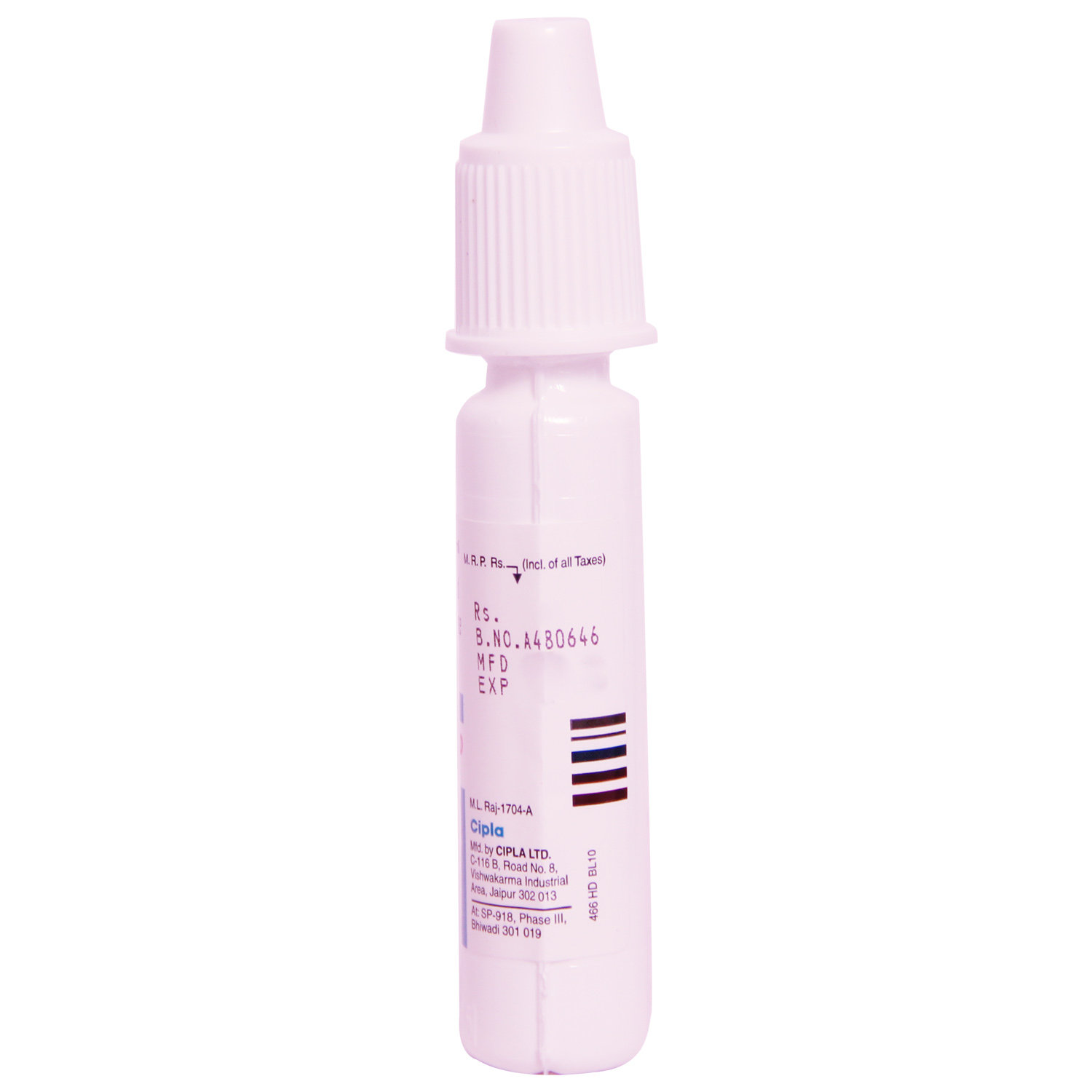OFLOX D EYE DROPS








MRP ₹25.5
(Inclusive of all Taxes)
₹3.8 Cashback (15%)
Provide Delivery Location
Online payment accepted
 Prescription drug
Prescription drugWhats That
Composition :
Manufacturer/Marketer :
Consume Type :
Return Policy :
Expires on or after :
About OFLOX D EYE DROPS
OFLOX D EYE DROPS is a combination of 'corticosteroid and antibiotic', primarily used to treat bacterial eye infections. Bacterial eye infection occurs when bacteria invade any part of the eyeball or its surrounding tissues, including the cornea (clear front surface of the eye) and the conjunctiva (thin membrane lining the outer eye and inner eyelids).
OFLOX D EYE DROPS contains Dexamethasone and Ofloxacin. Dexamethasone belongs to the class of corticosteroids. It blocks the production of prostaglandins (chemical messengers) that make the affected area red, swollen, and itchy. Ofloxacin belongs to a class of drugs called quinolone antibiotics. It is bactericidal (kills bacteria) and works by inhibiting bacterial DNA gyrase, an enzyme required for the replication, transcription, and repair of the DNA.
Use OFLOX D EYE DROPS in the dose and duration prescribed by your doctor based on your medical condition. OFLOX D EYE DROPS is generally safe to use. However, some may experience side effects like eye discomfort, eye irritation, burning/stinging sensation, dryness, redness, and itching. Most of these side effects of OFLOX D EYE DROPS do not require medical attention and gradually resolve over time. If these side effects persist longer, please consult your doctor.
If you are allergic to OFLOX D EYE DROPS or any other medicines, please tell your doctor. Inform your doctor if you have any liver or kidney diseases, fungal infections, or heart problems before using OFLOX D EYE DROPS. Pregnant and breastfeeding women should use OFLOX D EYE DROPS with proper consultation and caution. Drive or operate machinery only when you do not experience any discomfort in the eyes after the usage of eye drops.
Uses of OFLOX D EYE DROPS
Directions for Use
Medicinal Benefits
OFLOX D EYE DROPS contains Dexamethasone and Ofloxacin. Dexamethasone is a corticosteroid and blocks prostaglandins' production (chemical messengers) that make the affected area red, swollen and itchy. Ofloxacin is a quinolone antibiotic that inhibits bacterial DNA gyrase, an enzyme required for DNA replication, transcription, and repair. Thus OFLOX D EYE DROPS treats bacterial eye infections.
Storage
- Take healthy and balanced diet.
- Exercise regularly and maintain the healthy lifestyle.
- Reduce the intake of caffeine.
- Use a pillow and elevate your head while sleeping.
- If you have discomfort, illness, or unease after taking medication, seek medical attention.
- Your treatment plan may be modified, including adjusting the dosage, substituting with an alternative medication, or discontinuing the medication. Additionally, certain lifestyle changes may be recommended to help manage symptoms.
- To manage discomfort, follow your doctor's advice, like getting plenty of rest, or staying hydrated, and practising stress-reducing techniques.
- Track your symptoms regularly and report any changes or concerns to your healthcare provider to manage the discomfort effectively.
- Consult your doctor if you experience skin redness, itching, or irritation after taking medication.
- Apply cool compresses or calamine lotion to the affected skin area to reduce irritation.
- Stay hydrated by drinking plenty of water to help alleviate symptoms and keep your skin soothing.
- Monitor your skin condition closely and promptly report any changes, worsening symptoms, or concerns to your healthcare provider.
- Burning sensation is an abnormal side effect that needs medical attention. To relieve the burning feeling, your doctor may prescribe painkillers or antidepressants.
- Focused exercises can improve strength and reduce burning by soothing muscles.
- Change in lifestyle and improving nutrition can reduce the causes of burning sensation and provide relief.
- Your doctor may suggest nerve block injections as it is related to sensation in the skin.
- Burning feeling in a specific area would need mild electrical currents to reduce pain that targets the nerve affected. This practice must be done only if your doctor mentions it.
- Change positions or take a break from activity to relieve symptoms, as stinging can disturb your regular patterns.
- Avoid postures that put much pressure on the body area where stinging is felt.
- If you have a vitamin deficiency, take supplements or change your diet.
- Exercise regularly to improve inner strength.
- Follow your doctor's instructions to prevent stinging.
- Massage the affected area gently to get temporary relief.
- Report the itching to your doctor immediately; they may need to change your medication or dosage.
- Use a cool, damp cloth on the itchy area to help soothe and calm the skin, reducing itching and inflammation.
- Keep your skin hydrated and healthy with gentle, fragrance-free moisturizers.
- Try not to scratch, as this can worsen the itching and irritate your skin.
- If your doctor prescribes, you can take oral medications or apply topical creams or ointments to help relieve itching.
- Track your itching symptoms and follow your doctor's guidance to adjust your treatment plan if needed. If the itching persists, consult your doctor for further advice.
Drug Warnings
Brief your medical history to the doctor if you are allergic to OFLOX D EYE DROPS or any of its components. Please let your doctor know if you have a history of liver or kidney diseases, heart problems, glaucoma, cataracts, recent eye surgery, viral diseases of the conjunctiva and cornea, severe nearsightedness, diabetes, or fungal infections of the eye. Please consult your doctor if you are pregnant, planning pregnancy or breastfeeding before using OFLOX D EYE DROPS. Avoid driving or operating machines since the administration of OFLOX D EYE DROPS cause blurred vision for a while after using. OFLOX D EYE DROPS should be used for children only when advised by a doctor.
Drug-Drug Interactions
Drug-Drug Interactions
Login/Sign Up
Using Mesoridazine together with Oflox D Eye Drops can increase the risk of an irregular heart rhythm that may be serious.
How to manage the interaction:
Taking Mesoridazine with Oflox D Eye Drops is not recommended, please consult your doctor before taking it. You should seek immediate medical attention if you develop sudden dizziness, lightheadedness, fainting, shortness of breath, or heart palpitations. Do not stop using any medications without talking to a doctor.
Using bepridil together with Oflox D Eye Drops drugs can increase the risk of an irregular heart rhythm that may be serious.
How to manage the interaction:
Taking Oflox D Eye Drops with Bepridil can cause an interaction, please consult your doctor before taking it. You should seek immediate medical attention if you develop sudden dizziness, lightheadedness, fainting, or fast or pounding heartbeats. Do not stop using any medications without consulting a doctor.
Coadministration of Oflox D Eye Drops with Cisapride can increase the risk or severity of irregular heart rhythms.
How to manage the interaction:
Taking Oflox D Eye Drops with Cisapride together can result in an interaction, it can be taken if your doctor has advised it. However, if you experience sudden dizziness, lightheadedness, fainting, shortness of breath, chest pain or tightness, rapid heartbeat, or memory loss, contact a doctor immediately. Do not discontinue any medications without consulting a doctor. Note: Cisapride is no longer available on the market. Cisapride should only be taken if prescribed by a doctor and closely monitored.
Coadministration of Oflox D Eye Drops with Saquinavir can increase the risk or severity of irregular heart rhythms.
How to manage the interaction:
Taking Oflox D Eye Drops with Saquinavir together is generally avoided as it can result in an interaction, it can be taken if your doctor has advised it. However, if you experience sudden dizziness, lightheadedness, fainting, shortness of breath, chest pain or tightness, rapid heartbeat, or memory loss, contact a doctor immediately. Do not discontinue any medications without consulting a doctor.
Using halofantrine together with Oflox D Eye Drops can increase the risk of an irregular heart rhythm that may be serious.
How to manage the interaction:
Taking Oflox D Eye Drops with Halofantrine can cause an interaction, please consult your doctor before taking it. You should seek immediate medical attention if you develop sudden dizziness, lightheadedness, fainting, shortness of breath, or heart palpitations. Do not stop using any medications without talking to a doctor.
Coadministration of Oflox D Eye Drops with Ziprasidone can increase the risk or severity of irregular heart rhythm.
How to manage the interaction:
Taking Oflox D Eye Drops with Ziprasidone together can result in an interaction, it can be taken if your doctor has advised it. However, if you experience sudden dizziness, lightheadedness, fainting, shortness of breath, chest pain or tightness, rapid heartbeat, or memory loss, contact a doctor immediately. Do not discontinue any medications without consulting a doctor.
The combination of Amiodarone and Oflox D Eye Drops may significantly increase the risk of an abnormal heart rhythm.
How to manage the interaction:
Although Amiodarone and Oflox D Eye Drops interact, it can be taken if prescribed by a doctor. If you get dizziness, lightheadedness, fainting, or fast or racing heartbeats, consult a doctor. Do not stop taking any medications without consulting a doctor.
Coadministration of Oflox D Eye Drops with Thioridazine can increase the risk or severity of irregular heart rhythms.
How to manage the interaction:
Taking Oflox D Eye Drops with Thioridazine together is generally avoided as it can result in an interaction, it can be taken if your doctor has advised it. However, if you experience sudden dizziness, lightheadedness, fainting, shortness of breath, chest pain or tightness, rapid heartbeat, or memory loss, contact a doctor immediately. Do not discontinue any medications without consulting a doctor.
Coadministration of Oflox D Eye Drops with Quinidine can increase the risk or severity of irregular heart rhythms.
How to manage the interaction:
Taking Oflox D Eye Drops with Quinidine together is generally avoided as it can result in an interaction, it can be taken if your doctor has advised it. However, if you experience sudden dizziness, lightheadedness, fainting, shortness of breath, chest pain or tightness, rapid heartbeat, or memory loss, contact a doctor immediately. Do not discontinue any medications without consulting a doctor.
Coadministration of Oflox D Eye Drops with Pimozide can increase the risk or severity of irregular heart rhythms.
How to manage the interaction:
Taking Oflox D Eye Drops with Pimozide together can result in an interaction, it can be taken if your doctor has advised it. However, if you experience sudden dizziness, lightheadedness, fainting, shortness of breath, chest pain or tightness, rapid heartbeat, or memory loss, contact a doctor immediately. Do not discontinue any medications without consulting a doctor.
Drug-Food Interactions
Drug-Food Interactions
Login/Sign Up
Diet & Lifestyle Advise
- Manage stress, eat healthily, drink plenty of water, exercise regularly, and get plenty of sleep.
- Eat food rich in antioxidants such as berries, spinach, kidney beans, dark chocolate, etc.
- Know your allergy triggers, such as pollen, dust and other factors.
- Do not rub your eyes even though some ophthalmic drugs make your eye itchy.
- If you wear contact lenses: Clean and replace contact lenses more often. Never share contact lenses. Always remember to wash your hands before inserting and after removing the contact lens.
- Avoid staring at digital screens for longer durations. Rest your eyes every 20 minutes.
- Avoid or limit the intake of alcohol and caffeine.
Side Effects of OFLOX D EYE DROPS
- Eye discomfort
- Eye irritation
- Burning/stinging sensation
- Dryness
- Redness
- Itching
Habit Forming
Therapeutic Class
Author Details
We provide you with authentic, trustworthy and relevant information
Drug-Diseases Interactions
Drug-Diseases Interactions
Login/Sign Up
FAQs
OFLOX D EYE DROPS contains Ofloxacin and Dexamethasone. It helps treat bacterial infections of the eye by preventing bacteria growth and reduces the redness and itchiness in the infected areas.
It is advised to remove your contact lens if you are wearing it while administering eye drops. Also, remember to wash your hands before and after administering eye drops to avoid contamination.
If you use other eye ointments/drops along with OFLOX D EYE DROPS, it is advised to maintain a gap of at least 5-10 minutes after each administration. Also, use eye drops before applying any ointments.
Do not stop using OFLOX D EYE DROPS even if you feel better until the doctor's advised course is finished. Your symptoms may improve, but the infection may not be cured completely.
Take the missed dose of OFLOX D EYE DROPS as soon as possible. However, if it is time for the next dose, skip the missed dose and go back to your regular dosing schedule.
Drug-Drug Interactions Checker List
- PHENYTOIN
- PHENOBARBITONE
- EPHEDRINE
- RITONAVIR
- COBICISTAT
- RIFAMPICIN
Disease/Condition Glossary
Bacterial eye infection: A bacterial eye infection occurs when bacteria invade any part of the eyeball or surrounding tissues, including the cornea (clear front surface of the eye) and the conjunctiva (thin membrane lining the outer eye inner eyelids). A bacterial eye infection symptoms include red eyes, pain, swelling of the eyes, watery eyes, itching, and blurry vision. Some very common eye infections are conjunctivitis (the inflammation and irritation of the eye's mucous membrane (conjunctiva), stye (bump on the eyelid), uveitis (inflammation of the uvea, middle layer of the eye), marginal keratitis (inflammation of the cornea), and blepharitis (inflammation of the eyelids).

Have a query?
Buy best Ocular products by
Entod Pharmaceuticals Ltd
Ajanta Pharma Ltd
Sunways (India) Pvt Ltd
Sun Pharmaceutical Industries Ltd
Cipla Ltd
Micro Labs Ltd
Allergan Healthcare India Pvt Ltd
Intas Pharmaceuticals Ltd
Raymed Pharmaceuticals Ltd
Nri Vision Care India Ltd
FDC Ltd
Jawa Pharmaceuticals India Pvt Ltd
Indoco Remedies Ltd
Sapient Laboratories Pvt Ltd
Senses Pharmaceuticals Pvt Ltd
Centaur Pharmaceuticals Pvt Ltd
Neomedix Healthcare India Pvt Ltd
Aromed Pharmaceuticals
Optho Remedies Pvt Ltd
Aurolab
Austrak Pvt Ltd
Lupin Ltd
Mankind Pharma Pvt Ltd
Zivira Labs Pvt Ltd
Optho Pharma Pvt Ltd
Synovia Life Sciences Pvt Ltd
Akumentis Healthcare Ltd
Eyekare
His Eyeness Ophthalmics Pvt Ltd
Protech Remedies Pvt Ltd
Runyon Pharmaceutical Pvt Ltd
Alcon Laboratories Inc
Syntho Pharmaceuticals Pvt Ltd
Alembic Pharmaceuticals Ltd
Bell Pharma Pvt Ltd
Klar Sehen Pvt Ltd
Sentiss Pharma Pvt Ltd
Irx Pharmaceuticals Pvt Ltd
Optho Life Sciences Pvt Ltd
Phoenix Remedies Pvt Ltd
Alkem Laboratories Ltd
Doctor Wonder Pvt Ltd
Hicare Pharma
Ipca Laboratories Ltd
Neon Laboratories Ltd
Okulus Drugs India
Pharmtak Ophthalmics (I) Pvt Ltd
Berry & Herbs Pharma Pvt Ltd
Glow Vision Pharmaceuticals
Kaizen Drugs Pvt Ltd
Choroid Laboratories Pvt Ltd
Indiana Opthalamics Pvt Ltd
Optica Pharmaceutical Pvt Ltd
Pharmatak Opthalmics India Pvt Ltd
Samarth Life Sciences Pvt Ltd
Vibgyor Vision Care
Mofon Drugs
Novartis India Ltd
Pharmia Biogenesis Pvt Ltd
Zydus Cadila
Appasamy Ocular Devices Pvt Ltd
Leeford Healthcare Ltd
Medivision Pharma Pvt Ltd
Orbit Life Science Pvt Ltd
X-Med Royal Pharma Pvt Ltd
Zee Laboratories Ltd
Aarma Laboratories
Guerison MS Inc
Laborate Pharmaceuticals India Ltd
Xtas Pharmaceuticals
Accurex Biomedical Pvt Ltd
Blucrab Pharma Pvt Ltd
Does Health Systems Pvt Ltd
Flagship Biotech International Pvt Ltd
Lavue Pharmaceuticals Pvt Ltd
Nutrilis Healthcare Pvt Ltd
Ursa Pharm India Pvt Ltd
Vee Remedies
Vyonics Health Care India Pvt Ltd
Warren Pharmaceuticals Pvt Ltd
Abbott India Ltd
Accvus Pharmaceuticals
Akums Drugs & Pharmaceuticals Ltd
Cadila Healthcare Ltd
Carevision Pharmaceuticals Pvt Ltd
Dey's Medical Stores (Mfg) Ltd
East West Pharma India Pvt Ltd
Eyedea Pharmaceuticals Pvt Ltd
Nimbus Healthcare Pvt Ltd
Ocuris Pharmaceuticals Pvt Ltd
Sherings Pharmaceuticals
Tarks Pharmaceuticals Pvt Ltd
Vcan Biotech
Vision Medilink
Aice Health Care Pvt Ltd
Appasamy Pharmaceuticals Pvt Ltd
Asperia Lifescience Pvt Ltd
Beatum Healthcare Pvt Ltd
East India Pharmaceutical Works Ltd
Grevis Pharmaceutical Pvt Ltd
Alcohol
Caution
Limit alcohol consumption while on treatment with OFLOX D EYE DROPS.
Pregnancy
Caution
There is limited data on how OFLOX D EYE DROPS affects pregnancy. Please consult your doctor if you are pregnant or planning pregnancy before using OFLOX D EYE DROPS.
Breast Feeding
Caution
It is not known if OFLOX D EYE DROPS affects breastfeeding. Please consult your doctor before using OFLOX D EYE DROPS if you are a breastfeeding mother.
Driving
Caution
OFLOX D EYE DROPS may cause side effects like temporary blurred vision, affecting your driving ability. Hence, do not drive or operate machinery in such cases. Drive only when you are alert and have clear vision.
Liver
Caution
Let your doctor know if you have any history of liver diseases before starting treatment with OFLOX D EYE DROPS.
Kidney
Caution
Let your doctor know if you have any history of kidney diseases before starting the treatment with OFLOX D EYE DROPS.
Children
Caution
OFLOX D EYE DROPS should be used for children only when recommended by a doctor.





